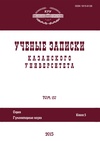Рече-поведенческие тактики приветствия в русском и китайском языках
The Speaking and Behavioral Tactics of Greeting in the Russian and Chinese Languages
Author(s): Aleftina Yuryevna Chernysheva, Wanjun ChangSubject(s): Language studies, Pragmatics, Psycholinguistics, Sociolinguistics
Published by: Казанский (Приволжский) федеральный университет
Keywords: speaking and behavioral tactics; Russia; China; secular culture; religious culture; appeal; elements of fatal communication;
Summary/Abstract: The problem of “politeness of rapprochement” (as first defined by Т.V. Larina) concerning the speaking and behavioral tactics of greeting in the Russian and Chinese languages has been considered. Treating the success and effectiveness of greeting tactics use in these languages is relevant due to the ongoing intensification in economic, political, and cultural contacts between Russia and China. The linguistic and cultural features of the speaking and behavioral tactics of greeting in the Russian and Chinese languages have been identified. It has been proved that the similarity concerns the communicative orientation of the tactics for rapprochement with the interlocutor, as well as their structure, including the direct formula of greeting, treatment, and elements of fatal communication. The observed differences concern the national specifics in the use of the speaking and behavioral tactics of greeting in Russia and China. In Russia, the speaking and behavioral tactics of greeting are used either in one of the cultures – secular (profane) or religious (Orthodox), or in both cultures at the same time. The national specificity of the use of the speaking and behavioral tactics of greeting in China is associated with appeals and elements of fatal communication. Despite the presence of considerable differences between Russia and China, the socio-psychological distance between communicants in Russia is less than in China, where the judicial relations are determined by profession, position, and often family, i.e., almost exclusively based on the hierarchy of kinship. The national specificity of the use of elements of fatal communication reflects the centuries-old conditions of life of the Chinese nation.
Journal: Ученые записки Казанского университета. Серия Гуманитарные науки
- Issue Year: 160/2018
- Issue No: 5
- Page Range: 1142-1150
- Page Count: 9
- Language: Russian

